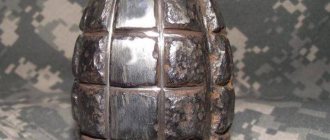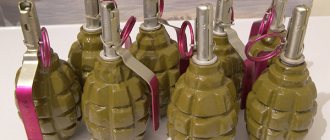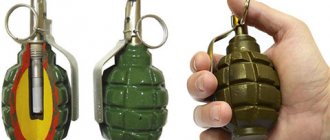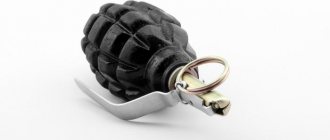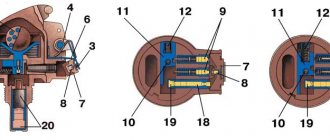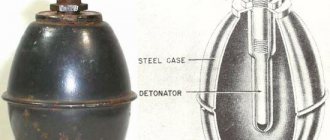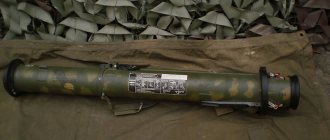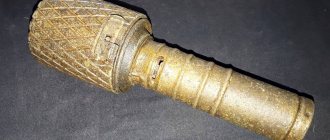History of the creation of the grenade
This simple, in its design, means of defense for the infantryman has gone through an interesting path. Its story begins in France.
It was here in 1915 that a grenade was created under the designation F1.
It proved itself to be the best and was soon adopted into service in Russia.
In our country, during the first war, I mean World War II, of course, it was improved.
A new fuse of the Koveshnikov system was invented.
But the main changes occurred during Soviet times.
- In 1939, based on a French model, they invented their own F-1 grenade. The developer of the explosive device, engineer Khrameev, used the same operating principle. However, he simplified and made the body more perfect.
- The next stage in the improvement of the F-1 dates back to the beginning of the Great Patriotic War. It was at this time that designer E.M. Viceni created a simpler, more reliable and more advanced fuse. At the same time, he was safer than before.
- During the Second World War, namely in 1942, a “unified fuse for hand grenades” was also developed, which later became universal for several types of grenades.
After the war, the fuse was modernized and its modifications UZRGM 1, 2 are used in F-1, RG-42, and also RGD
Grenade device
F-1 fragmentation, anti-personnel grenade, designed for throwing from cover. As can be seen from the photographs, the appearance of the device has not undergone significant changes over the course of a century.
The grenade body is so ideal in its design that there was no need to change anything about it.
The device of a hand grenade is very simple:
- the explosive device consists of a metal body (steel cast iron), oval in shape with fins, so that after it explodes, as many fragments as possible are formed;
- a fuse of the UZRGM type, in which, compared to the UZRG, the design of the firing pin has been changed, which makes it possible to minimize weapon failure during use;
- explosive mixture, this is TNT or trinitrophenol (dry picric acid), there are options when the explosive has a mixed composition. In this case, the base is usually pyroxylin (nitrocellulose).
That is, the grenade contains only three main parts: the body, the fuse, and the explosive.
The main advantage of this simplicity is reliability.
Specifications
The performance characteristics (performance characteristics) of the F-1 are summarized in a table and present the following picture:
| Weight | 600g |
| Weight of explosive filling | 60g |
| How far can you throw | 50-60m |
| Dispersion radius of lethal grenade fragments | 40-50m |
| At what distance is it safe to be in the event of an explosion? | 200m |
| Moderator burning time | 3-4sec |
| Number of fragments after explosion | up to 300 |
| Length | 110cm |
The characteristics of the F1 grenade indicate that this explosive device is almost ideal for defensive operations. And also for using it in sabotage activities.
The radius of destruction allows you to inflict significant damage to enemy personnel.
The grenade is very effective when used in tripwires, as a defensive measure if it is not possible to install anti-personnel mines.
When to throw guarantors in PUBG
The use of grants in the game is varied, they can be used when storming a house, throwing smoke at windows where shots are possible, throwing fragmentation grenades into rooms where an opponent may be.
Smoke grenades can be used when your team is retreating or advancing. Molotov cocktails can also be used in the house, limiting the movement of opponents around the house, cutting off the path of attack on you when you are being treated.
The video explains how to pull the pin on a grenade and how to throw it. After watching the video you will learn how to do it yourself.
How does the fuse work?
The combat properties of a grenade largely depend on its fuse, and it consists of:
- checks, which are a metal ring, a pin made from a piece of wire that passes through the hole in the fuse;
- striker, a metal rod, it is pointed at one end;
- a spring that drives the hammer;
- release lever in the form of a plate, its purpose is to block the firing pin after the pin is removed;
- capsule;
- retarder;
- detonator.
The action diagram of a hand grenade fuse looks like this:
- after the pin is removed, the firing pin is held using the release lever;
- by releasing the lever, and this happens during throwing, the striker is activated and pierces the capsule with its sharp end;
- The moderator ignites, after a few seconds the detonator fires, and an explosion occurs.
The projectile is fired with a delay to give the throwing soldier time to take cover. The technical characteristics of the F1 grenade allow it to effectively hit the enemy.
Lemon and features of its use
There are some features of storing this projectile. They consist in the fact that the fuse and the body with the explosive are stored separately in a wooden box. The fuse is screwed into the grenade before the battle.
In the operating instructions, the article on storing fuses states that they should be kept in special sealed boxes. This is to prevent them from corroding.
How to distinguish a training grenade from a combat one? In this sense, labeling is of particular importance. Combat grenades are painted green and dark green. And the grenade model is painted black.
This is done in order to visually immediately distinguish a combat grenade from an imitation grenade. And the latter, naturally, is used to avoid accidents during soldier training.
But this is not the only way to distinguish them. The model of the training grenade has 1 ring from the pin, as well as the lower part, the very tip of the lever, which must be pressed after removing the pin, is painted red.
Soldiers must carry grenades in a special pouch designed for two projectiles. Or in unloading, and transportation in pockets is also allowed. But under no circumstances should you hook the projectiles to the belt by the pin rings.
Lecture No. Topic: Hand fragmentation grenades. Safety measures and handling procedures.
Lecture No.
Topic: Hand fragmentation grenades. Safety measures and handling procedures.
Target
: Familiarization of students with the design of hand fragmentation grenades RGD - 5, F - 1, RGN and RGO. Installation of UZRGM and UDZ fuses.
Basic terms and concepts:
device of hand fragmentation grenades RGD - 5, F - 1, RGN and RGO. Installation of UZRGM and UDZ fuses.
Lecture outline :
1. Classification of hand fragmentation grenades.
2. Purpose, combat properties and design of hand-held fragmentation grenades RGD - 5, F - 1, RGN and RGO. Installation of UZRGM and UDZ fuses.
3. Handling, caring for and saving pomegranates.
Lecture content:
1.Classification of hand fragmentation grenades
.
Hand fragmentation grenades
are designed to destroy enemy personnel with shrapnel in close combat (in open areas, in trenches or communication passages, when fighting in a populated area, in a forest or mountains).
When a grenade ruptures, it forms a large number of flying fragments, which have sufficient energy to destroy manpower.
Depending on the range of scattering of fragments and purpose, grenades are divided into:
— anti-personnel: offensive and defensive;
- anti-tank;
— special: signal (smoke, noise) and gas
Anti-personnel grenades include
:
— offensive grenades RGD-5 and RGN;
— defensive grenades F-1 and RGO.
Hand fragmentation grenades are equipped with UZRGM fuses (unified hand grenade fuse, modernized) and
UDZ (impact-remote fuse).
In addition to combat grenades, there are also training and training-imitation grenades used in military units for training purposes. Combat grenades are painted green (from light to dark green), and training and simulation grenades are painted black. In addition, they have a hole at the bottom. The fighting fuse has no color. In the training and simulation fuse, the pin ring and the lower part of the pressure lever are painted red.
Depending on the range of scattering of fragments, grenades are divided
into offensive and defensive.
The average throwing range of hand fragmentation grenades is 30-50 m, anti-tank grenades - 15-20 m. The explosion produces a large number of fragments that fly in different directions. RGD-5, RG-42 and F-1 grenades explode reliably in any environment: swamp, snow, water, etc.
Characteristics of grenades
F-1 hand fragmentation grenade
The F-1 hand fragmentation grenade is a long-range grenade designed to destroy manpower primarily in defensive combat. You can throw a grenade from various positions and only from behind cover, from an armored personnel carrier or a tank (self-propelled artillery unit).
| Characteristics of the F-1 fragmentation grenade | |
| Type of grenade - Defensive Grenade weight - 600 g Weight of explosive charge - 60 g Type of fuse - UZRGM Moderator burning time - 3.2-4.2 sec Dispersion radius of lethal fragments - 200 m Radius of the zone of effective destruction of manpower - 7 m Average throw range — 20-40 m | |
| F-1 grenade device | |
| The F-1 hand fragmentation grenade consists of a body, an explosive charge and a fuse. The body of the grenade serves to house the explosive charge and fuse, as well as to form fragments when the grenade explodes. The grenade body is cast iron, with longitudinal and transverse grooves. In the upper part of the body there is a threaded hole for screwing in the fuse. When storing, transporting and carrying the grenade, a plastic plug is screwed into this hole. The explosive charge fills the body and serves to break the grenade into fragments. | |
RGD-5 hand fragmentation grenade
The RGD-5 hand-held fragmentation grenade is a remote-action grenade designed to destroy enemy personnel on the offensive and in defense. Throwing a grenade is carried out from various positions when operating on foot and on an armored personnel carrier (vehicle).
| Characteristics of the RGD-5 fragmentation grenade | |
| Type of grenade: offensive Grenade weight - 310 g Weight of explosive charge - 60 g Fuse type UZRGM Moderator burning time - 3.2-4.2 sec Dispersion radius of lethal fragments - 25 m Radius of the zone of effective destruction of manpower - 5 m Average throw range - 30-45 m | |
| Design of the RGD-5 grenade | |
| 1 - igniter tube with cuff 2 - cap with liner 3 - tray with liner | |
The RGD-5 hand fragmentation grenade consists of a body with a tube for a fuse, a bursting charge and a fuse.
The body of the grenade serves to house the explosive charge, the fuse tube, and also to form fragments when the grenade explodes. It consists of two parts - upper and lower.
The upper part of the body consists of an outer shell, called a cap, and a cap liner. An igniter tube is attached to the upper part using a cuff. The tube serves to attach the fuse to the grenade and to seal the explosive charge in the body. To protect the tube from contamination, a plastic plug is screwed into it. When preparing a grenade for throwing, instead of a plug, a fuse is screwed into the tube.
The lower part of the housing consists of an outer shell, called the pan, and a pan liner. The explosive charge fills the body and serves to break the grenade into fragments.
F-1 and RGD-5 hand fragmentation grenades are equipped with a modernized unified fuse for hand grenades (UZRGM).
Unified hand grenade fuse modernized UZRGM
The UZRGM grenade fuse (unified hand grenade fuse, modernized) is intended to explode the explosive charge.
The impact mechanism serves to ignite the igniter primer. It consists of a hammer tube, a connecting sleeve, a guide washer, a mainspring, a firing pin, a firing pin washer, a trigger lever and a safety pin with a ring.
The impact mechanism tube is the basis for assembling all parts of the igniter. The connecting sleeve serves to connect the fuse to the grenade body. It is placed on the bottom of the impact mechanism tube. The guide washer is a stop for the upper end of the mainspring and directs the movement of the firing pin. It is fixed in the upper part of the impact mechanism tube.
UZRGM device
It consists of a striking mechanism and the fuse itself.
| Impact mechanism | |
| 1 – hammer tube 2 – guide washer 3 – mainspring 4 – hammer 5 – hammer washer 6 – trigger lever 7 – safety pin with ring 8 – connecting sleeve | |
| Fuse | |
| 9 – primer – igniter 10 – moderator bushing 11 – moderator 12 – primer – detonator | |
In official use, the striker is constantly cocked and held by the trigger lever fork. The trigger lever is connected to the percussion mechanism tube by a safety pin. Before throwing a grenade, the plastic plug is turned out and the fuse is screwed in its place.
When throwing a grenade, take it in your hand so that the trigger lever is pressed with your fingers against the body of the grenade. Continuing to press the trigger lever tightly, with your free hand you compress (straighten) the ends of the safety pin, which is pulled out of the fuse by the ring with your finger. After pulling the pin, the position of the fuse parts does not change. At the moment the grenade is thrown, the trigger lever separates and releases the firing pin. The firing pin, under the action of the mainspring, pierces the igniter capsule. A beam of fire from the primer ignites the moderator and, after passing through it, is transmitted to the detonator primer. The explosion of the detonator capsule initiates the detonation of the explosive charge. The explosion of the explosive charge crushes the grenade body into fragments.
RGO fragmentation grenade
| Characteristics of the RGO fragmentation grenade | |
| Type of grenade - Defensive Grenade weight - 530 g Weight of explosive charge - 92 g Type of fuse - UDZ Moderator burning time - 3.3-4.3 sec Dispersion radius of lethal fragments - 150 m Radius of effective destruction zone manpower - 12 m Average throw range - 20-40 m | |
| The device of the RGO grenade | |
| 1 – glass with cuff 2 – upper outer and inner hemispheres 3 – lower outer and inner hemispheres | |
RGN fragmentation grenade
| Characteristics of the RGN fragmentation grenade | |
| Type of grenade - Offensive Grenade weight - 310 g Weight of explosive charge - 114 g Type of fuse - UZ Moderator burning time - 3.3-4.3 sec Dispersion radius of lethal fragments - 24 m Radius of the effective destruction zone manpower - 8 m Average throw range - 30-45 m | |
| RGN grenade device | |
| 1 – glass with cuff 2 – upper hemisphere 3 – lower hemisphere | |
RGO and RGN hand fragmentation grenades are equipped with a remote-impact fuse
Impact-remote fuse UDZ
| 1 – Nakolno body – safety mechanism 2 – trigger lever 3 – hammer with sting 4 – mainspring 5 – ring with pin 6 – strap 7 – plug 8 – primer – igniter Long-range cocking mechanism 9 – powder fuses 10 – primer – igniter 11 – slider 12 – spring Target sensor 13 – sting 14 – spring 15 – sleeve 16 – sleeve 17 – weight Self-liquidating mechanism 18 – moderator 19 – capsule – detonator Detonation unit 20 – capsule – detonator |
Interaction of parts and mechanisms
Initial position
In the initial position, the striker with the sting (3) and the plug with the igniter primer (7) are held by the trigger lever. The trigger lever is connected to the igniter body by a safety pin. The engine (11) with the igniter capsule (10) is offset relative to the tip (13) and is held by the powder fuses stoppers (9), its spring (12) is in a compressed state. The bushing (16) under the influence of the spring (14) presses the load (17).
Position of parts and mechanisms in official circulation
| When preparing a grenade for throwing, the trigger lever is pressed tightly with your fingers to the body of the grenade, the ends of the safety pin are straightened with the fingers of your free hand, then it is pulled out by the ring, while the position of the fuse parts does not change. At the moment the grenade is thrown, the trigger lever separates and releases the striker with the sting (3) and the bar (6). The plug (7) with the igniter capsule comes out of the igniter housing socket. The firing pin, under the action of the mainspring (4), pierces the igniter primer (8) with its sting. The fire beam ignites the powder press-fit fuses (9) and the pyrotechnic composition of the self-liquidator moderator (18). After 1-1.8 seconds. The powder compositions of the fuses burn out and their stoppers, under the influence of springs, disengage with the engine (11). The engine, under the influence of the spring (12), moves into the firing position. The long-range cocking mechanism prevents the grenade from being detonated if it accidentally falls from the hand. |
2. Safety measures when handling grenades.
Before throwing a grenade, you should unscrew the plug from the tube and screw the fuse in its place until it stops.
To throw a grenade, hold the grenade in your hands so that the trigger lever is pressed against the grenade body with your fingers. Without releasing the lever, pull the safety pin by the ring and throw the grenade at the target. At the moment the grenade is thrown, the trigger lever separates from the grenade and releases the firing pin. The firing pin, under the influence of the mainspring, strikes (pricks) the igniter primer and ignites it. When hitting an obstacle or after the fuse deceleration time has expired, the detonator capsule explodes and causes an explosion of the grenade's explosive charge. The body of the grenade bursts and fragments fly in different directions.
When learning to throw grenades:
1) trainees must wear steel helmets;
2) before loading, inspect the grenades and fuses; in case of detection of malfunctions, report to the commander;
3) throwing defensive fragmentation and anti-tank grenades from a trench or from behind cover not penetrated by fragments, under the direction of an officer;
4) when one trainee throws several grenades, throw each subsequent grenade at least 5 seconds after the explosion of the previous one;
5) if the grenade was not thrown (the safety pin was not removed), it should be unloaded only upon command and under the direct supervision of the commander;
6) keep a record of unexploded grenades and mark the places where they fell with red flags;
at the end of throwing, destroy unexploded grenades by detonation at the place of impact in accordance with the rules set out in the Guidelines for the storage and conservation of artillery weapons and ammunition in the military; the detonation of grenades (fuses) is organized by the unit commander;
Trainees who have successfully completed exercises in throwing training and training-simulation grenades are allowed to throw combat grenades.
Loading a grenade (inserting the fuse) is permitted only before throwing it.
Military grenades should only be issued to those trained in their use.
It is prohibited to disassemble live grenades and troubleshoot them, carry grenades outside of bags (hanging by the safety pin ring), and also touch unexploded grenades.
To study the structure of grenades, techniques and rules for throwing them, it is necessary to use training, training and simulation grenades and posters.
Each military personnel must accurately and unquestioningly comply with the established safety requirements when handling weapons at the training site.
Personnel who have not mastered the safety requirements are not allowed to throw grenades.
It is prohibited to throw grenades in conditions of limited visibility, if the main and dangerous throwing directions are not visible from the place of the shooting director on the site.
Grenades are carried in grenade bags. The fuses are placed in them separately from the grenades, and each fuse is wrapped in paper or rags.
Grenades and fuses must be inspected before placing in the bag and before loading.
The body of the grenade should not have deep dents or deeply penetrated rust.
The igniter tube and igniter must be clean, free from dents and rust; the ends of the safety pin must be spread apart and not have cracks at the bends.
Fuses with cracks and green deposits cannot be used.
When carrying grenades, they must be protected from shocks, blows, fire, dirt and dampness.
Soaked and contaminated grenades and fuses must be wiped and dried under the supervision of the commander; Do not dry them near the fire.
Grenades and fuses must be protected from sudden shocks, impacts, fire, contamination and humidity
.
Knowledge control:
Give answers to the questions:
1. What is a hand fragmentation grenade called?
2. What color are combat grenades painted?
3. What combat properties of hand fragmentation grenades do you know?
4. Tell us about the structure of hand fragmentation grenades.
5. What is the purpose of hand fragmentation grenades?
6. In what type of combat and where are hand fragmentation grenades used?
7. What other grenades are there, besides combat ones, what color are they painted?
8. What is the range of fragments of the RGD-5 hand grenade and the F-1 grenade?
9. What is the average throwing range of hand fragmentation and anti-tank grenades?
10. What is the mass of charged RGD-5 and F-1 grenades?
11. Briefly describe the hand-held anti-tank cumulative grenade.
12. Tell us about handling pomegranates, care and storage.
Homework:
learn the notes, prepare a message on the topic “Anti-tank grenades and special-purpose grenades.”
Preparing and throwing a grenade
The characteristics of the F-1 require a responsible attitude towards the process of preparing and throwing a grenade. Moreover, these shells are defensive, which means they require honed skills in handling them.
- First of all, you need to straighten the wire antennae that secure the pin so that it does not spontaneously fall out of the fuse.
- In this case, the right hand holds the trigger lever. Now you can pull the pin. You can hold the grenade in this position for a long time and even, if necessary, insert the pin back.
- Having chosen the moment, the grenade is thrown at the target. The trigger lever releases the firing pin, which activates the primer and an explosion occurs.
How long does it take for a grenade to explode?
Maximum time 4 seconds.
When using this type of explosive device, enemy personnel suffer from damage from shrapnel.
About correct use
Before use, the soldier must straighten the safety tendrils, and then take the grenade so that his hand completely fixes the clamping lever to the body. Just before throwing (!) you need to pull the pin. You can keep the “lemon” in this position for an indefinitely long time, since when the lever is compressed, the capsule is not initiated, and therefore an explosion will not occur.
Once a target is selected, you should vigorously throw a grenade at it. At this moment the lever will turn, releasing the firing pin, and fly off to the side. The firing pin initiates the primer (by puncturing it), and after three to four seconds an explosion occurs.
Do you remember how in films they repeatedly showed an episode when a desperate sailor (soldier, revolutionary, partisan, etc.) in a last, desperate jerk pulls out the pin with his teeth? If you decide to repeat this trick, make sure you have a good dentist in advance, since you will 100% have to change your front teeth. Even with his hand, if the fixing tendrils are not straightened, such a feat can only be accomplished by Schwarzenegger in his youth, so what kind of teeth are there... In a word, don’t even think about tearing out the pin in this way!
Real use in combat
In open areas, the high-explosive effect (overpressure damage) of F-1 is noticeable at a distance of 3 - 5 meters from the explosion site. The radius of action of fragments (confident destruction) reaches 50, sometimes 70 meters.
The largest fragments can fly 200 meters from the epicenter of the explosion.
These features also dictate the methods of using a grenade in battle:
- it is most effective in confined spaces, that is, in rooms where the destructive power of fragments is maximum;
- indoors and the high-explosive effect is enhanced several times, which leads to concussions and also completely disorients;
- F-1 is very useful when organizing sabotage as the main element of tripwires, as well as for blowing up vehicles, warehouses, etc.
Sometimes tripwires are placed using two or more grenades.
And if you remove the moderator, you can achieve one important advantage, i.e., an instant explosion.
The same effect will be given by grenades equipped with a mine fuse, which acts instantly.
About the scattering of fragments and luck
It is difficult to talk about the maximum throwing range: if a soldier is a master of sports in discus throwing, it can exceed 100 meters. A physically developed person will throw it (on average) 30-35 meters. The fragments (in practice) scatter approximately 30 meters
An important digression must be made here
Almost all instructions say that the lemon grenade “scatters” fragments over 150-200 meters. This is not entirely fantasy: indeed, individual “scraps” can fly to such a distance. But in this case there is no talk about the zone of guaranteed destruction.
Moreover, in other situations, fragments even from the RG-42 fly 200 meters, the creators of which did not even mention such records. This is not an indicator. The experience of participants in real combat operations says that the guaranteed destruction zone for mines, grenades and similar “goods” is approximately 35-40 meters, no more. If further, then everything depends on individual luck. If you’re really, really lucky, there’s a chance you’ll survive even a meter away from the exploding lemonade.
Advantages and disadvantages
The F-1 grenade has been in service with many armies for decades. In the near future, and even in the distant future, it is unlikely to be discontinued.
The reason for this is its undeniable advantages.
- Ease of manufacture and low cost of the material from which the body is made.
- A simple and reliable fuse that operates remotely and reliably.
- High lethality, especially in confined spaces.
The disadvantages of this projectile include the very small fragments formed during the explosion. They have low lethality.
The disadvantage of its fuse is that the moderator gives the enemy a chance of salvation, albeit a small one. The F-1 is a rather heavy projectile; not everyone can throw more than half a kilogram of cargo far and accurately.
Offensive grenades RGD are a kind of analogue of the F-1. But they are twice as light as it, but they also contain twice as much explosive. The RGD grenade has the same type of fuse as the F-1.
Due to the smaller number of fragments, but a greater high-explosive effect, it is used in offensive operations.
Another type is the Rgn offensive grenade. Their advantage over F1 is also their lighter weight.
In addition, the range of action of both the RGD and RGN is of considerable importance - 15 - 20 meters.
